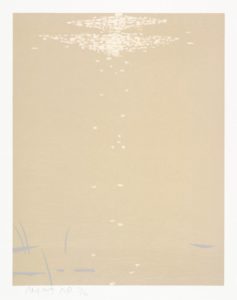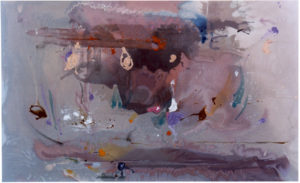 It doesn’t happen all that often these days, but I found myself home alone in New York last Friday night. Mrs. T was in Connecticut. I had no show to see that evening, nor was a pressing deadline hanging over my head, so I sent out for sushi, read a novel while I ate it, watched a movie I’d seen a half-dozen times before, lit a candle and watched it burn, and enjoyed the pleasant sensation of having nothing in particular to do.
It doesn’t happen all that often these days, but I found myself home alone in New York last Friday night. Mrs. T was in Connecticut. I had no show to see that evening, nor was a pressing deadline hanging over my head, so I sent out for sushi, read a novel while I ate it, watched a movie I’d seen a half-dozen times before, lit a candle and watched it burn, and enjoyed the pleasant sensation of having nothing in particular to do.
As I walked into the kitchen to throw away an apple core, my eye happened to fall on one of the two dozen pieces of art that hang on the walls of our New York apartment, Alex Katz’s “Northern Landscape (Bright Light),” a delicate print made in 1992 that bears a striking resemblance to a Japanese woodcut. “Bright Light” is so soft-spoken that it doesn’t make much of an impression at first glance, and even though I pass by whenever I go into or leave the kitchen, I tend not to look at it anymore. For some reason, though, “Bright Light” caught my eye that night, and all at once it came to life and filled my heart with unexpected joy.
A year after I started collecting art in 2003, I wrote an essay in which I observed that “the only good reason to buy a piece of art” is “so that you can look at it every day, as often as you want.” Nowadays I’d put the same thought somewhat differently: the wonderful thing about living in an apartment full of art is that you are constantly re-encountering it. Sometimes—fairly often, truth to tell—I’m too distracted to think more than casually, if at all, about what I’m seeing, but the art is always there, waiting to be noticed, and sooner or later I notice it.
 Mrs. T and I have chosen the pieces that we own with great care, and so far none of them has “gone dead on the wall,” as longtime collectors say. While we each have our particular favorites, I can honestly say that I love every work in our collection. That doesn’t mean, however, that I look at each and every piece whenever I’m home. A few of our prints, Helen Frankenthaler’s “Grey Fireworks” in particular, are so large and spectacular that they’re hard not to notice, while others, like “Northern Landscape (Bright Light),” are easy to overlook, rather like a shy child who never speaks up in class. And you know what? It doesn’t matter, not in the least.
Mrs. T and I have chosen the pieces that we own with great care, and so far none of them has “gone dead on the wall,” as longtime collectors say. While we each have our particular favorites, I can honestly say that I love every work in our collection. That doesn’t mean, however, that I look at each and every piece whenever I’m home. A few of our prints, Helen Frankenthaler’s “Grey Fireworks” in particular, are so large and spectacular that they’re hard not to notice, while others, like “Northern Landscape (Bright Light),” are easy to overlook, rather like a shy child who never speaks up in class. And you know what? It doesn’t matter, not in the least.
All this puts me in mind of a poem by W.H. Auden that has deep personal meaning for me:
Looking up at the stars, I know quite well
That, for all they care, I can go to hell,
But on earth indifference is the least
We have to dread from man or beast.
How should we like it were stars to burn
With a passion for us we could not return?
If equal affection cannot be,
Let the more loving one be me.
Like Auden, I’ve loved that way in the past, and I’m glad I don’t anymore. I’m glad, too, that the “stars” on the wall of our apartment are indifferent to the pleasure that they give, and to the mysterious fact that some of them give it more freely than others. When you live with art, it’s perfectly all right, even inevitable, that you’ll take it for granted from time to time. The art doesn’t care. It just is.


